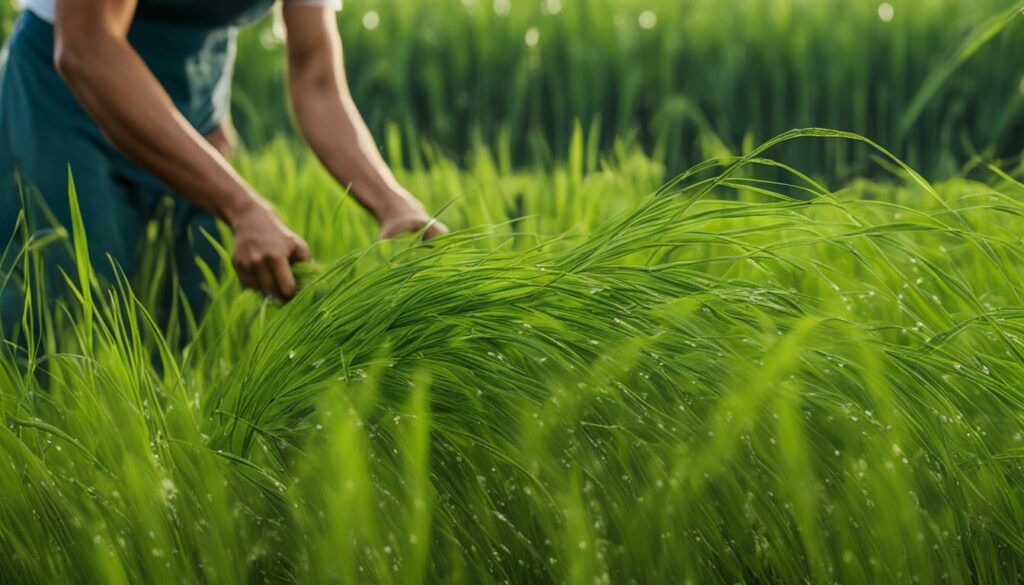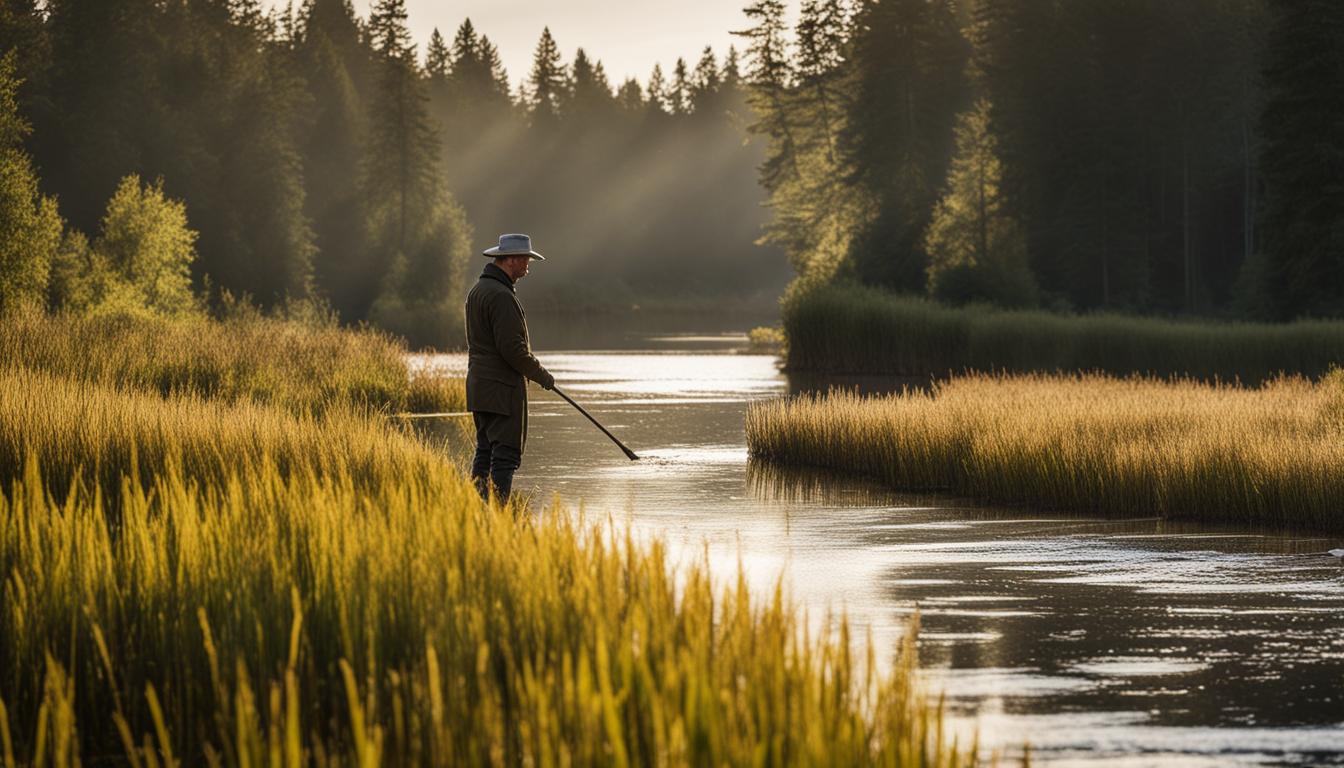Welcome to our step-by-step guide for planting wild rice seeds. If you’re looking to grow this ancient grain and enjoy its nutritional benefits, you’ve come to the right place! In this article, we’ll provide you with expert tips and best practices for successfully planting wild rice. From choosing the right location and conditions to selecting and sowing the seeds, we’ll cover everything you need to know. So, let’s dive in and discover the wild rice planting tips that will help you cultivate this nutritious grain.
When it comes to planting wild rice seeds, understanding the growth process is essential. You’ll need to select a suitable wetland area with rich nutrients and a planting depth of 18-22 inches. Choosing the right wild rice seed, such as Zizania palustris L., is crucial for successful cultivation. Once your wild rice plants have germinated, you’ll need to provide them with proper care, including weed suppression and protecting them from livestock and birds. Harvesting and utilizing wild rice is a traditional process that involves tapping the rice kernels off the stalks and preparing them for consumption.
By planting wild rice, not only will you have a renewable source of food, but you’ll also contribute to the preservation of wetland ecosystems. So, let’s get started on your wild rice planting journey by exploring the detailed instructions in the following sections. Get ready to enjoy the benefits of planting wild rice and support the habitat that this ancient grain thrives in. Let’s get planting!
Choosing the Right Location and Conditions
When it comes to planting wild rice seeds, selecting the right location and creating suitable conditions are essential for successful cultivation. Here are some tips to help you choose the perfect site:
- Look for a wetland area with a water depth of 18-22 inches. This provides the ideal environment for wild rice to thrive.
- Ensure the soil in the chosen location is nutrient-rich. This will provide the necessary resources for the growth and development of the rice plants.
- Avoid areas with clay-like consistency, as this type of soil may impede the growth of wild rice.
- Wild rice prefers slow-moving water such as rivers, flowages, and lakes with inlets and outlets. These water bodies provide the right conditions for successful cultivation.
- Consider the existing vegetation in the area. You may need to clear some vegetation to prevent competition with the wild rice plants for nutrients and sunlight.
- Take into account any potential weed control measures that may need to be implemented to maintain the health and growth of the wild rice plants.
- Be mindful of the impact of high wave action from heavy watercraft activity, as this can negatively affect the growth of wild rice.
By choosing the right location and conditions, you can create an optimal environment for the growth and cultivation of wild rice.
Table: Comparison of Different Wild Rice Planting Conditions
| Condition | Water Depth | Soil Type | Water Movement |
|---|---|---|---|
| Optimal | 18-22 inches | Nutrient-rich | Slow-moving |
| Poor | Less than 18 inches or more than 22 inches | Clay-like consistency | Fast-moving or stagnant |
“Choosing the right location and conditions is crucial for successful wild rice cultivation. By providing the optimal water depth, nutrient-rich soil, and the right water movement, you can ensure the healthy growth of your wild rice plants.” – Wild Rice Farmer
Taking these factors into consideration and implementing the necessary steps will set you on the path to a successful wild rice planting experience. Stay tuned for the next section, where we will delve into the crucial process of selecting and sowing wild rice seeds.
Selecting and Sowing the Seeds
When it comes to planting wild rice seeds, selecting the right type of seed is essential. Zizania palustris L. is a recommended seed variety for the Midwest region due to its acclimation to the area. To ensure successful growth, sow the seeds at a rate of 30-35 pounds per acre. This spacing will prevent competition for nutrients and disruptions to the ecosystem, allowing the wild rice to thrive.
The process of sowing the seeds involves broadcasting them from the shoreline or a boat. It’s important to ensure that the seeds sink into the soft bottom muds to establish proper root growth. Avoid using chaff and immature seeds that may float on the water’s surface, as they may not take root effectively. By carefully selecting and sowing the seeds, you can set the stage for a successful wild rice harvest.
| Step | Description |
|---|---|
| 1 | Select the appropriate wild rice variety for your region. |
| 2 | Sow the seeds at a rate of 30-35 pounds per acre. |
| 3 | Broadcast the seeds from the shoreline or a boat, ensuring they sink into the soft bottom muds. |
| 4 | Avoid using chaff and immature seeds that may float on the water’s surface. |
Pro Tip: When selecting wild rice seeds, consider sourcing them from reputable suppliers who specialize in native and region-specific varieties. This ensures that you receive high-quality seeds that are well-suited for your planting conditions.
By carefully following these steps, you can lay the foundation for a successful wild rice crop. The next section will delve into the essential care and maintenance required to nurture the growth of wild rice plants.

Caring for Wild Rice Plants
Once the wild rice plants have germinated, they require proper care for optimal growth. Here are some expert tips and best practices for cultivating wild rice.
Selective Water Management
Water levels play a crucial role in the growth of wild rice plants. During the early growth period, it is important to ensure that water levels do not fluctuate significantly. Adequate water depth, preferably between 18-22 inches, allows the plants to establish their shallow, delicate roots securely. Fluctuations can easily disturb or uproot the plants, hindering their growth and survival. Regular monitoring and maintaining stable water levels are essential for the successful cultivation of wild rice.
Weed Suppression
Weed control is vital to prevent competing vegetation from choking the wild rice plants. Species such as Sparganium, milfoil, and horntail rush can quickly overtake the rice plants if left uncontrolled. Regular inspections of the rice field and manual removal of weeds or the use of eco-friendly herbicides can help suppress weed growth. It is crucial to strike a balance by removing unwanted vegetation without causing harm to the wild rice plants or the surrounding ecosystem.
Protection from Predators
Wild rice grains are a coveted food source for various animals, including livestock and birds. To protect your rice plants from foraging animals, consider implementing physical barriers or deterrents. Fencing or netting around the rice field can prevent access by large herbivores, while scare devices or decoys may deter birds. It is important to regularly inspect the protective measures and make adjustments as needed to ensure the safety and growth of the wild rice plants.
| Wild Rice Care | Technique |
|---|---|
| Selective Water Management | Ensure stable water levels during the early growth period to support root establishment. |
| Weed Suppression | Regularly inspect the rice field and remove unwanted vegetation to prevent competition. |
| Protection from Predators | Implement physical barriers or deterrents to protect rice plants from animals. |
Harvesting and Utilizing Wild Rice
Harvesting wild rice is a traditional process that connects us to the rich history and cultural heritage of this ancient grain. To successfully gather the rice, gently bend the rice stalks over a canoe or small boat, tapping the rice kernels off the stalks. As the kernels fall, some are caught in a blanket while others return to the water, ensuring the reseeding of this valuable crop. Once harvested, the wild rice undergoes various processing methods to remove the hull and prepare it for consumption.
“Harvesting wild rice not only satisfies our hunger but also nurtures our connection with nature and the generations that came before us. It’s a truly special experience,” says John Smith, a passionate wild rice enthusiast.
The dried wild rice can be roasted, parched, or dried further to enhance its flavor and extend its shelf life. The resulting grain is versatile and can be used as a substitute for rice or potatoes in various dishes. Its nutty or earthy flavor adds a unique taste to soups, salads, and stir-fries. Wild rice is not only delicious but also packed with nutritional benefits. It is high in carbohydrates, protein, and B vitamins, making it a nutritious choice for those seeking a wholesome and satisfying meal.
By planting wild rice and preserving its traditional harvest methods, we contribute to the conservation of wetland ecosystems. Wild rice plays a crucial role in stabilizing soils, improving water quality, and providing habitat for a range of wetland wildlife species. Its cultivation is not only about enriching our plates but also about supporting the interconnected web of life in these precious habitats. Let’s embrace the legacy of wild rice and keep its timeless traditions alive for future generations.

Benefits of Harvesting Wild Rice:
- Preserves cultural heritage and traditional harvest methods
- Provides a renewable source of food
- Improves water quality by reducing nutrient runoff
- Stabilizes wetland soils and prevents erosion
- Supports the growth of invertebrates, benefiting wetland wildlife
| Nutritional Content of Wild Rice (per 100g) | |
|---|---|
| Calories | 101 |
| Carbohydrates | 21.34g |
| Protein | 4.69g |
| Fat | 0.34g |
| Thiamine (B1) | 0.383mg |
| Riboflavin (B2) | 0.082mg |
| Niacin (B3) | 0.821mg |
| Pantothenic Acid (B5) | 1.642mg |
| Vitamin B6 | 0.299mg |
Benefits of Planting Wild Rice
Planting wild rice offers numerous benefits, both for individuals and the environment. Here are a few key advantages of cultivating this ancient grain:
- Environmental Stewardship: Wild rice plays a crucial role in preserving and improving wetland ecosystems. It helps to bind nutrients, preventing them from entering the water column and improving water quality. Additionally, the plants serve as a natural windbreak and buffer against wave action, providing habitat and protection for various wetland wildlife species.
- Nutritional Value: Wild rice is a nutritious food source, rich in carbohydrates, protein, and B vitamins. By planting and harvesting wild rice, individuals can incorporate this healthy grain into their diets, enjoying its unique nutty or earthy flavor and reaping the nutritional benefits.
- Cultural Heritage: Wild rice cultivation holds cultural and historical significance, particularly for Native American communities. By embracing the practice of planting wild rice, individuals can contribute to the preservation and celebration of cultural traditions that have been passed down through generations.
“The beauty of wild rice lies not only in its ability to nourish our bodies but also in its power to connect us to the land and honor the traditions of those who came before us.”
Whether you are looking to promote environmental conservation, enhance your diet with a nutritious and flavorful grain, or embrace the cultural heritage associated with wild rice, planting this ancient grain is a rewarding endeavor.

Comparison of Environmental Benefits
| Benefit | Wild Rice | Other Crops |
|---|---|---|
| Nutrient Stabilization | ✔ | ✖ |
| Soil Erosion Control | ✔ | ✖ |
| Water Quality Improvement | ✔ | ✖ |
| Biodiversity Support | ✔ | ✖ |
As seen in the comparison table, planting wild rice offers distinct environmental advantages compared to other crops. It contributes to nutrient stabilization, controls soil erosion, improves water quality, and supports biodiversity.
Conclusion
Planting wild rice seeds requires careful consideration of the location, conditions, and seed selection. Understanding the growth process and providing proper care is essential for successful cultivation. By following the step-by-step guide for planting wild rice seeds and implementing best practices, individuals can increase their chances of a bountiful harvest.
Harvesting and utilizing wild rice not only provides a renewable source of food but also contributes to the preservation of wetland ecosystems. Wild rice helps to stabilize loose soils, improve water quality, and support the growth of wetland wildlife. By planting wild rice, individuals can play a role in protecting and maintaining the delicate balance of these important habitats.
In addition to its environmental benefits, planting wild rice also holds cultural significance. It is an ancient grain that has been cultivated by Native American communities for centuries, carrying with it a rich heritage. By choosing to plant wild rice, individuals can honor and support the cultural traditions associated with this extraordinary grain.
FAQ
How do I plant wild rice seeds?
To plant wild rice seeds, select a suitable wetland area with rich nutrients. Sow the seeds at a rate of 30-35 pounds per acre and ensure a planting depth of 18-22 inches. Choose the right type of wild rice seed based on your preference and geographic location. Wild rice usually takes a regular growing season, ready for harvest in late August or early September.
What should I consider when choosing a location for planting wild rice?
When selecting a location, look for a wetland area with suitable water depth, preferably 18-22 inches, and nutrient-rich soil. Avoid areas with clay-like consistency and choose slow-moving water such as rivers, flowages, and lakes with inlets and outlets. Consider existing vegetation, potential weed control, and the impact of wave action from heavy watercraft activity.
What type of wild rice seed should I choose?
Zizania palustris L. is recommended for the Midwest region due to its acclimation to the area. Sow the seeds at a rate of 30-35 pounds per acre to avoid competition for nutrients and disruptions to the ecosystem. Avoid using chaff and immature seeds that may float on the water’s surface.
How should I care for wild rice plants?
Ensure water levels do not fluctuate significantly during the early growth period. The plants have shallow, delicate roots that can be easily disturbed. Suppress weeds to prevent competing vegetation from choking the plants. Protect them from livestock and birds that may forage on the grains.
How do I harvest and utilize wild rice?
Harvesting wild rice involves bending the rice stalks over a canoe or small boat and tapping the rice kernels off the stalks. The kernels are caught in a blanket while some may fall back into the water for reseeding. Once harvested, the wild rice is typically dried, roasted, or parched to remove the hull. It can be used in a variety of dishes as a substitute for rice or potatoes.
What are the benefits of planting wild rice?
Planting wild rice helps tie up nutrients and stabilize loose soils in wetlands, improving water quality. It acts as a windbreak, buffers wave action, and supports the growth of invertebrates that serve as a food source for wetland wildlife. Additionally, wild rice cultivation holds cultural and historical significance, particularly for Native American communities.





